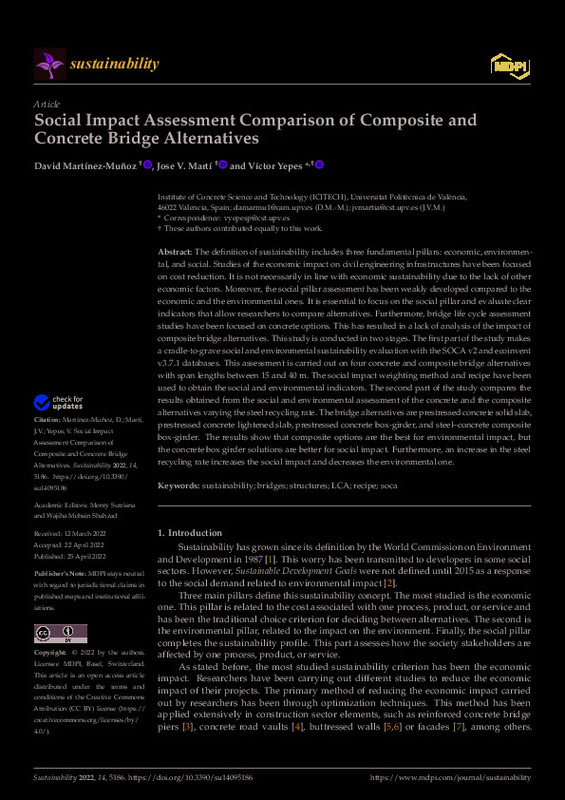JavaScript is disabled for your browser. Some features of this site may not work without it.
Buscar en RiuNet
Listar
Mi cuenta
Estadísticas
Ayuda RiuNet
Admin. UPV
Social Impact Assessment Comparison of Composite and Concrete Bridge Alternatives
Mostrar el registro sencillo del ítem
Ficheros en el ítem
| dc.contributor.author | Martínez-Muñoz, D.
|
es_ES |
| dc.contributor.author | Martí Albiñana, José Vicente
|
es_ES |
| dc.contributor.author | Yepes, V.
|
es_ES |
| dc.date.accessioned | 2022-11-21T19:01:13Z | |
| dc.date.available | 2022-11-21T19:01:13Z | |
| dc.date.issued | 2022-05 | es_ES |
| dc.identifier.uri | http://hdl.handle.net/10251/190004 | |
| dc.description.abstract | [EN] The definition of sustainability includes three fundamental pillars: economic, environmental, and social. Studies of the economic impact on civil engineering infrastructures have been focused on cost reduction. It is not necessarily in line with economic sustainability due to the lack of other economic factors. Moreover, the social pillar assessment has been weakly developed compared to the economic and the environmental ones. It is essential to focus on the social pillar and evaluate clear indicators that allow researchers to compare alternatives. Furthermore, bridge life cycle assessment studies have been focused on concrete options. This has resulted in a lack of analysis of the impact of composite bridge alternatives. This study is conducted in two stages. The first part of the study makes a cradle-to-grave social and environmental sustainability evaluation with the SOCA v2 and ecoinvent v3.7.1 databases. This assessment is carried out on four concrete and composite bridge alternatives with span lengths between 15 and 40 m. The social impact weighting method and recipe have been used to obtain the social and environmental indicators. The second part of the study compares the results obtained from the social and environmental assessment of the concrete and the composite alternatives varying the steel recycling rate. The bridge alternatives are prestressed concrete solid slab, prestressed concrete lightened slab, prestressed concrete box-girder, and steel¿concrete composite box-girder. The results show that composite options are the best for environmental impact, but the concrete box girder solutions are better for social impact. Furthermore, an increase in the steel recycling rate increases the social impact and decreases the environmental one. | es_ES |
| dc.description.sponsorship | This research was funded by: Grant PID2020-117056RB-I00 funded byMCIN/AEI/10.13039/501100011033 and by "ERDF A way of making Europe". Grant FPU-18/01592 funded by MCIN/AEI/10.13039/501100011033 and by "ESF invests in your future". | es_ES |
| dc.language | Inglés | es_ES |
| dc.publisher | MDPI AG | es_ES |
| dc.relation.ispartof | Sustainability | es_ES |
| dc.rights | Reconocimiento (by) | es_ES |
| dc.subject | Sustainability | es_ES |
| dc.subject | Bridges | es_ES |
| dc.subject | Structures | es_ES |
| dc.subject | LCA | es_ES |
| dc.subject | Recipe | es_ES |
| dc.subject | Soca | es_ES |
| dc.subject.classification | INGENIERIA DE LA CONSTRUCCION | es_ES |
| dc.title | Social Impact Assessment Comparison of Composite and Concrete Bridge Alternatives | es_ES |
| dc.type | Artículo | es_ES |
| dc.identifier.doi | 10.3390/su14095186 | es_ES |
| dc.relation.projectID | info:eu-repo/grantAgreement/AEI/Plan Estatal de Investigación Científica y Técnica y de Innovación 2017-2020/PID2020-117056RB-I00/ES/OPTIMIZACION HIBRIDA DEL CICLO DE VIDA DE PUENTES Y ESTRUCTURAS MIXTAS Y MODULARES DE ALTA EFICIENCIA SOCIAL Y MEDIOAMBIENTAL BAJO PRESUPUESTOS RESTRICTIVOS/ | es_ES |
| dc.relation.projectID | info:eu-repo/grantAgreement/ //FPU18%2F01592//AYUDA PREDOCTORAL FPU-MARTINEZ MUÑOZ/ | es_ES |
| dc.rights.accessRights | Abierto | es_ES |
| dc.contributor.affiliation | Universitat Politècnica de València. Escuela Técnica Superior de Ingenieros de Caminos, Canales y Puertos - Escola Tècnica Superior d'Enginyers de Camins, Canals i Ports | es_ES |
| dc.description.bibliographicCitation | Martínez-Muñoz, D.; Martí Albiñana, JV.; Yepes, V. (2022). Social Impact Assessment Comparison of Composite and Concrete Bridge Alternatives. Sustainability. 14(9):1-19. https://doi.org/10.3390/su14095186 | es_ES |
| dc.description.accrualMethod | S | es_ES |
| dc.relation.publisherversion | https://doi.org/10.3390/su14095186 | es_ES |
| dc.description.upvformatpinicio | 1 | es_ES |
| dc.description.upvformatpfin | 19 | es_ES |
| dc.type.version | info:eu-repo/semantics/publishedVersion | es_ES |
| dc.description.volume | 14 | es_ES |
| dc.description.issue | 9 | es_ES |
| dc.identifier.eissn | 2071-1050 | es_ES |
| dc.relation.pasarela | S\462269 | es_ES |
| dc.contributor.funder | European Social Fund | es_ES |
| dc.contributor.funder | AGENCIA ESTATAL DE INVESTIGACION | es_ES |
| dc.contributor.funder | European Regional Development Fund | es_ES |
| dc.contributor.funder | MINISTERIO DE CIENCIA INNOVACION Y UNIVERSIDADES | es_ES |








